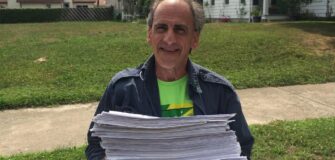Sustainability the goal in city
Share
†
Santa Monica has committed itself to avoiding environmental damage, not just cleaning up after it.
by Kevin McKeown, Green Party of California†
Wed 10/01/03†
GreenPages, Vol 7, No.3
With two Greens on its city council, including a former mayor, Mike Feinstein, and the current mayor pro tem, Kevin McKeown, Santa Monica has committed itself to avoiding environmental damage, not just cleaning up after it.
Walking along Santa Monica’s beachside cliffs, one might not realize the colorful 130-foot Ferris wheel sparkling below is the world’s first to run on solar power. On sunny days, 650 photovoltaic panels keep the wheel spinning and visitors smiling without a single volt of fossil fuel electricity.
That attractive, artsy building next to the pier? Santa Monica’s pioneering urban runoff recycling facility gurgles as it catches the number one source of pollution affecting Santa Monica Bay.
This facility converts an average 500,000 gallons a day of runoff into “gray water” that is then used throughout Santa Monica for irrigation. In the new Civic Center, buildings will be “double-piped” so the reclaimed water can be used to flush, saving fresh potable water.
Green elected officials and appointed Green board and commission members have been key to developing and implementing Santa Monica’s policy of proactive stewardship of this urban ecosystem.
When the lights come on at any municipal facility, not only do efficient fixtures conserve, but the electricity itself is 100 percent from renewable resources. That cute green downtown shuttle is zero-emission electric, and transit fleet is quickly converting to compressed natural gas.
Residents have pitched in as well. Santa Monica offers commingled recycling, so households needn’t separate glass, paper and cans. The new single-bin system was an instant hit, with residential recycling up 11 percent.
Santa Monica’s pioneering efforts have made the city an international leader and role model for municipal sustainability. Even after meeting or exceeding many of the initial targets, though, Greens realize their efforts are incomplete.
Many challenges remain before Santa Monica truly can call itself a sustainable city.
Beginning in 2001, a large team of community stakeholders, including elected and appointed officials, city staff and representatives of neighborhood organizations, schools, the business community and other community groups examined Santa Monica’s long-term sustainability with an expanded perspective.
Santa Monica’s longstanding Task Force on the Environment, vice-chaired by Green Sandy Grant, developed and updated goals and indictors. The new plan enjoyed unanimous embrace at the city council.
For the first time, long-term sustainability factors were included, such as mixed-use planning choices to encourage multimodal transportation and reduce car dependency.
Goals have been set for more parks and for more unpaved, rainfall-permeable open space, focusing not just on human usage of the city but on natural land functions.†
Distant jobs without transportation options perpetuate the Southern California “commute and pollute” lifestyle, so the new Sustainable City Plan includes housing clustered around mass transit nodes.
A head start has already been made on the Green Building Guidelines with an affordable housing project that generates its own electricity from attractive glass-panel photovoltaics on the sunny sides of the building.
What about the natural resource impacts enthusiastically encouraged by corporate consumer society? For the first time, Santa Monica’s “ecological footprint” will become a factor when the city and its residents consider consumption.
The ecological footprint is a measure of how one’s use of Earth’s resources measures against the portion of the planet to which one is justly entitled.
Santa Monicans will begin to take greater personal responsibility for how personal consumption choices affect the community’s ecological footprint, even though the specific impacts and resource wastage engendered by habits may occur outside the city.
One plan element makes Santa Monica the first known city to have a policy favoring vegetarianism. Although the emphasis is to educate, not mandate, one of the plan’s desired outcomes will be an annual increase in the percentage of residents who report that vegetable-based foods dominate their diet.
With Green Party leadership, Santa Monica has set itself a challenge: avoiding future environmental impacts by modifying over time the unsustainable activities of residents, businesses, institutions and visitors.†
Years of work lay ahead, but Santa Monica is well on the way to creating the basis for a more sustainable way of life for current and future generations.




